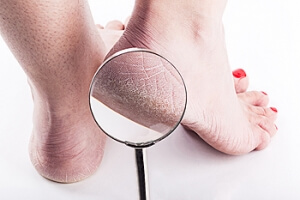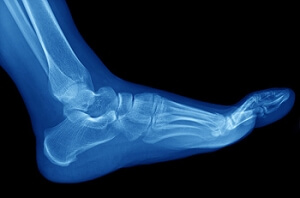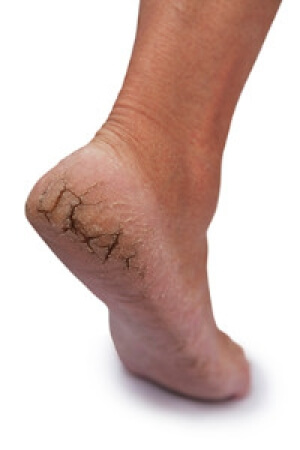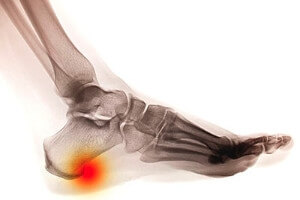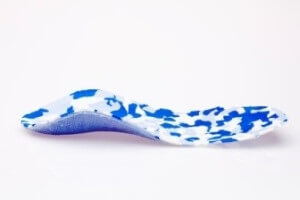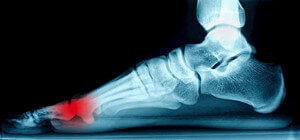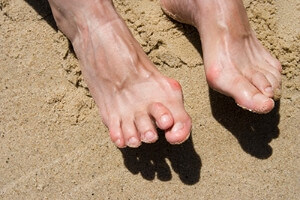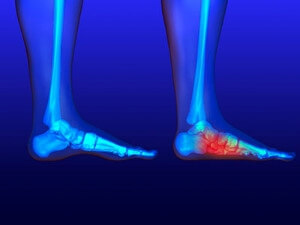Connect With Us
Featured Articles
Super User
Treating and Preventing Cracked Heels
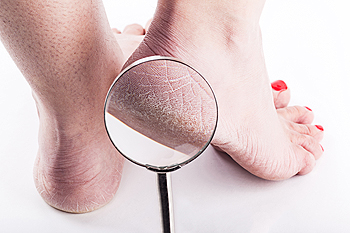 Cracked heels are generally a minor and common – albeit discomforting – foot condition. The heels typically become cracked because of a lack of moisture. Therefore, it is important to moisturize your feet if they tend to become dry. Apply a moisturizer twice daily to help prevent the skin on the feet from becoming cracked. Washing your feet daily in a foot bath can help as well. It is important to keep the foot dry beyond moisturizing because bacteria and fungus thrive in wet and hot environments, like the feet. Wear socks that allow the feet to breath. Cotton socks are standard wear for most people and should be fine, but synthetic socks generally wick away moisture and allow for better air circulation. Similarly, shoes should be breathable as well.
Cracked heels are generally a minor and common – albeit discomforting – foot condition. The heels typically become cracked because of a lack of moisture. Therefore, it is important to moisturize your feet if they tend to become dry. Apply a moisturizer twice daily to help prevent the skin on the feet from becoming cracked. Washing your feet daily in a foot bath can help as well. It is important to keep the foot dry beyond moisturizing because bacteria and fungus thrive in wet and hot environments, like the feet. Wear socks that allow the feet to breath. Cotton socks are standard wear for most people and should be fine, but synthetic socks generally wick away moisture and allow for better air circulation. Similarly, shoes should be breathable as well.
Cracked heels are unsightly and can cause further damage to your shoes and feet. If you have any concerns, contact one of our podiatrists from New Jersey Foot & Ankle Centers. Our doctors can provide the care you need to keep you pain-free and on your feet.
Cracked Heels
Cracked heels appear unappealing and can make it harder for you walk around in sandals. Aside from looking unpleasant, cracked heels can also tear stockings, socks, and wear out your shoes. There are several methods to help restore a cracked heel and prevent further damage.
How Do You Get Them?
Dry skin is the number one culprit in creating cracked heels. Many athletes, walkers, joggers, and even swimmers suffer from cracked heels. Age and skin oil production play a role to getting cracked heels as well.
Promote Healing
Over the counter medicines can help, especially for those that need instant relief or who suffer from chronic dry feet.
Wear Socks – Wearing socks with medicated creams helps lock in moisture.
Moisturizers – Applying both day and night will help alleviate dryness which causes cracking.
Pumice Stones – These exfoliate and remove dead skin, which allows for smoother moisturizer application and better absorption into the skin.
Change in Diet
Eating healthy with a well-balanced diet will give the skin a fresh and radiant look. Your body responds to the kinds of food you ingest. Omega-3 fatty acids and zinc supplements can also revitalize skin tissue.
Most importantly, seek professional help if unsure how to proceed in treating cracked heels. A podiatrist will help you with any questions or information needed.
If you have any questions, please feel free to contact our office located in Oradell, NJ . We offer the newest diagnostic and treatment technologies for all your foot care needs.
Read more about Solutions for Cracked HeelsHow do Stress Fractures Happen?
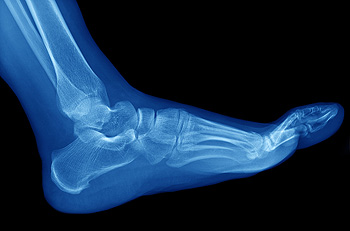 Stress fractures develop when a bone that’s constantly under stress eventually weakens. It typically occurs on the outside of the bone and happens due to repetitive motion. Many professional athletes and runners develop this condition, as overuse of the bones in the foot is common. The way the foot is structured may be another cause, as having flat feet or higher arches may be a contributing factor in developing stress fractures. When overdoing a specific activity, the risk is high for developing these fractures. There may not be physical signs and symptoms from the fracture, but when the activity resumes, pain is often felt. An x-ray is used to determine exactly where the fracture is. Recovery comes from resting the foot and being careful not to put stress on the bones. Occasionally a medical boot is worn to keep the fracture from worsening, in addition to engaging in physical therapy. Please seek the advice of a podiatrist if you feel you have a stress fracture in the foot or ankle.
Stress fractures develop when a bone that’s constantly under stress eventually weakens. It typically occurs on the outside of the bone and happens due to repetitive motion. Many professional athletes and runners develop this condition, as overuse of the bones in the foot is common. The way the foot is structured may be another cause, as having flat feet or higher arches may be a contributing factor in developing stress fractures. When overdoing a specific activity, the risk is high for developing these fractures. There may not be physical signs and symptoms from the fracture, but when the activity resumes, pain is often felt. An x-ray is used to determine exactly where the fracture is. Recovery comes from resting the foot and being careful not to put stress on the bones. Occasionally a medical boot is worn to keep the fracture from worsening, in addition to engaging in physical therapy. Please seek the advice of a podiatrist if you feel you have a stress fracture in the foot or ankle.
Activities where too much pressure is put on the feet can cause stress fractures. To learn more, contact one of our podiatrists from New Jersey Foot & Ankle Centers. Our doctors can provide the care you need to keep your pain free and on your feet.
Dealing with Stress Fractures of the Foot and Ankle
Stress fractures occur in the foot and ankle when muscles in these areas weaken from too much or too little use. The feet and ankles then lose support when walking or running from the impact of the ground. Since there is no protection, the bones receive the full impact of each step. Stress on the feet can cause cracks to form in the bones, thus creating stress fractures.
What Are Stress Fractures?
Stress fractures occur frequently in individuals whose daily activities cause great impact on the feet and ankles. Stress factors are most common among:
- Runners
- People affected with Osteoporosis
- Tennis or basketball players
- Gymnasts
- High impact workouts
Symptoms
Pain from the fractures occur in the area of the fractures and can be constant or intermittent. It will often cause sharp or dull pain with swelling and tenderness. Engaging in any kind of activity which involves high impact will aggravate pain.
If you have any questions please feel free to contact our office located in Oradell, NJ . We offer the newest diagnostic and treatment technologies for all your foot and ankle needs.
Read more about Dealing with Stress Fractures of the Foot and AnkleWhat Treatment Options Are Available for Cracked Heels?
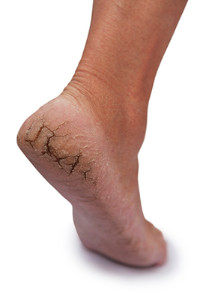 One of the most common causes of cracked heels is a lack of moisture. Typically, a callus will begin to form, and when coupled with dryness the skin can split. This is often accompanied by pain and bleeding. Other medical causes may include thyroid disease, diabetes, and vitamin deficiency, in addition to possibly wearing incorrect shoes. Calluses can form from having dropped arches, affecting the heel as walking occurs, which may put additional stress on the foot. These conditions can cause the skin to become less supple and can incur diminished flexibility while walking, therefore leading to cracks in the skin. Treatments may include practicing improved nutrition and applying moisturizers. The skin on the heel will possibly feel more comfortable when the hardened calluses are removed. A consultation with a podiatrist may be considered for treatment options if cracked heels are affecting your day to day activities.
One of the most common causes of cracked heels is a lack of moisture. Typically, a callus will begin to form, and when coupled with dryness the skin can split. This is often accompanied by pain and bleeding. Other medical causes may include thyroid disease, diabetes, and vitamin deficiency, in addition to possibly wearing incorrect shoes. Calluses can form from having dropped arches, affecting the heel as walking occurs, which may put additional stress on the foot. These conditions can cause the skin to become less supple and can incur diminished flexibility while walking, therefore leading to cracks in the skin. Treatments may include practicing improved nutrition and applying moisturizers. The skin on the heel will possibly feel more comfortable when the hardened calluses are removed. A consultation with a podiatrist may be considered for treatment options if cracked heels are affecting your day to day activities.
Cracked heels are unsightly and can cause further damage to your shoes and feet. If you have any concerns, contact one of our podiatrists from New Jersey Foot & Ankle Centers. Our doctors can provide the care you need to keep you pain-free and on your feet.
Cracked Heels
Cracked heels appear unappealing and can make it harder for you walk around in sandals. Aside from looking unpleasant, cracked heels can also tear stockings, socks, and wear out your shoes. There are several methods to help restore a cracked heel and prevent further damage.
How Do You Get Them?
Dry skin is the number one culprit in creating cracked heels. Many athletes, walkers, joggers, and even swimmers suffer from cracked heels. Age and skin oil production play a role to getting cracked heels as well.
Promote Healing
Over the counter medicines can help, especially for those that need instant relief or who suffer from chronic dry feet.
Wear Socks – Wearing socks with medicated creams helps lock in moisture.
Moisturizers – Applying both day and night will help alleviate dryness which causes cracking.
Pumice Stones – These exfoliate and remove dead skin, which allows for smoother moisturizer application and better absorption into the skin.
Change in Diet
Eating healthy with a well-balanced diet will give the skin a fresh and radiant look. Your body responds to the kinds of food you ingest. Omega-3 fatty acids and zinc supplements can also revitalize skin tissue.
Most importantly, seek professional help if unsure how to proceed in treating cracked heels. A podiatrist will help you with any questions or information needed.
If you have any questions, please feel free to contact our office located in Oradell, NJ . We offer the newest diagnostic and treatment technologies for all your foot care needs.
Types of Heel Spurs
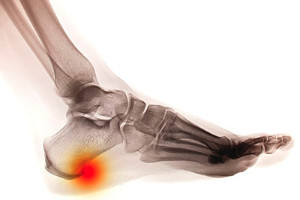 Heel spurs can be divided into two categories. Heel spur syndrome, often associated with a commonly known condition referred to as plantar fasciitis, is caused by a bony growth forming on the bottom of the heel. This type of heel spur may be a result of the ligaments and muscles becoming strained. Sports that involve running and jumping are often associated with causing this condition. Insertional Achilles tendonitis is the result of the spur developing at the back of the heel, where the Achilles tendon adheres to the bone. It may become inflamed and irritated, causing damage to a portion or all of the Achilles tendon. The spur may develop gradually and is generally not linked to an injury. This can be a painful condition in the heel and may cause discomfort in the bottom of the calf where it meets the tendon. A consultation with a podiatrist is recommended for treatment of either of these conditions.
Heel spurs can be divided into two categories. Heel spur syndrome, often associated with a commonly known condition referred to as plantar fasciitis, is caused by a bony growth forming on the bottom of the heel. This type of heel spur may be a result of the ligaments and muscles becoming strained. Sports that involve running and jumping are often associated with causing this condition. Insertional Achilles tendonitis is the result of the spur developing at the back of the heel, where the Achilles tendon adheres to the bone. It may become inflamed and irritated, causing damage to a portion or all of the Achilles tendon. The spur may develop gradually and is generally not linked to an injury. This can be a painful condition in the heel and may cause discomfort in the bottom of the calf where it meets the tendon. A consultation with a podiatrist is recommended for treatment of either of these conditions.
Heel spurs can be incredibly painful and sometimes may make you unable to participate in physical activities. To get medical care for your heel spurs, contact one of our podiatrists from New Jersey Foot & Ankle Centers. Our doctors will do everything possible to treat your condition.
Heels Spurs
Heel spurs are formed by calcium deposits on the back of the foot where the heel is. This can also be caused by small fragments of bone breaking off one section of the foot, attaching onto the back of the foot. Heel spurs can also be bone growth on the back of the foot and may grow in the direction of the arch of the foot.
Older individuals usually suffer from heel spurs and pain sometimes intensifies with age. One of the main condition's spurs are related to is plantar fasciitis.
Pain
The pain associated with spurs is often because of weight placed on the feet. When someone is walking, their entire weight is concentrated on the feet. Bone spurs then have the tendency to affect other bones and tissues around the foot. As the pain continues, the feet will become tender and sensitive over time.
Treatments
There are many ways to treat heel spurs. If one is suffering from heel spurs in conjunction with pain, there are several methods for healing. Medication, surgery, and herbal care are some options.
If you have any questions feel free to contact our office located in Oradell, NJ . We offer the latest in diagnostic and treatment technology to meet your needs.
Read more about Heel SpursCan Orthotics Help More Than My Feet?
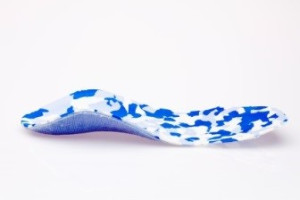 If you are experiencing abnormal walking patterns, you may want to consider wearing orthotics. Orthotics are custom-made inserts that are slipped into your shoes. Generally, an impression of your feet is taken to obtain a perfect fit, preventing any feelings of discomfort. The benefits of wearing orthotics may include keeping the foot stable while performing daily activities and helping to correct debilitating pronation. They’re also beneficial in aiding in conditions such as bunions, corns, and heel pain. It may take some time to get used to your new orthotics, since your feet have been functioning in a certain way for years. Therefore, a gradual increase in wearing them may be recommended. Please consider a consultation with a podiatrist for advice on how you can be measured for custom-made orthotics.
If you are experiencing abnormal walking patterns, you may want to consider wearing orthotics. Orthotics are custom-made inserts that are slipped into your shoes. Generally, an impression of your feet is taken to obtain a perfect fit, preventing any feelings of discomfort. The benefits of wearing orthotics may include keeping the foot stable while performing daily activities and helping to correct debilitating pronation. They’re also beneficial in aiding in conditions such as bunions, corns, and heel pain. It may take some time to get used to your new orthotics, since your feet have been functioning in a certain way for years. Therefore, a gradual increase in wearing them may be recommended. Please consider a consultation with a podiatrist for advice on how you can be measured for custom-made orthotics.
If you are having discomfort in your feet and would like to try orthotics, contact one of our podiatrists from New Jersey Foot & Ankle Centers. Our doctors can provide the care you need to keep you pain-free and on your feet.
What Are Orthotics?
Orthotics are inserts you can place into your shoes to help with a variety of foot problems such as flat feet or foot pain. Orthotics provide relief and comfort for minor foot and heel pain but can’t correct serious biomechanical problems in your feet.
Over-the-Counter Inserts
Orthotics come in a wide variety of over-the-counter inserts that are used to treat foot pain, heel pain, and minor problems. For example, arch supports can be inserted into your shoes to help correct overarched or flat feet, while gel insoles are often used because they provide comfort and relief from foot and heel pain by alleviating pressure.
Prescription Orthotics
If over-the-counter inserts don’t work for you or if you have a more severe foot concern, it is possible to have your podiatrist prescribe custom orthotics. These high-quality inserts are designed to treat problems such as abnormal motion, plantar fasciitis, and severe forms of heel pain. They can even be used to help patients suffering from diabetes by treating foot ulcers and painful calluses and are usually molded to your feet individually, which allows them to provide full support and comfort.
If you are experiencing minor to severe foot or heel pain, it’s recommended to speak with your podiatrist about the possibilities of using orthotics. A podiatrist can determine which type of orthotic is right for you and allow you to take the first steps towards being pain-free.
If you have any questions please contact our office located in Oradell, NJ . We offer the newest diagnostic and treatment technologies for all your foot and ankle needs.
Read more about Foot OrthoticsWhat is Sesamoiditis?
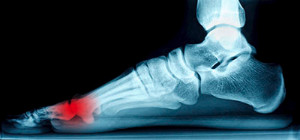 The tendons attached to the bones located on the sole of the foot are referred to as the sesamoid bones. If these tendons become inflamed, typically resulting from an injury, a condition known as sesamoiditis occurs. A common symptom is pain experienced under the ball of the foot while walking, or discomfort may be felt from standing on your toes because the tendons are stretched. Choosing to wear high heels in addition to participating in sports that involve running and jumping may be common causes of this condition. Treatment may include ceasing the activity that caused sesamoiditis and considering a consultation with a podiatrist for custom-made insoles to provide relief.
The tendons attached to the bones located on the sole of the foot are referred to as the sesamoid bones. If these tendons become inflamed, typically resulting from an injury, a condition known as sesamoiditis occurs. A common symptom is pain experienced under the ball of the foot while walking, or discomfort may be felt from standing on your toes because the tendons are stretched. Choosing to wear high heels in addition to participating in sports that involve running and jumping may be common causes of this condition. Treatment may include ceasing the activity that caused sesamoiditis and considering a consultation with a podiatrist for custom-made insoles to provide relief.
Sesamoiditis is an unpleasant foot condition characterized by pain in the balls of the feet. If you think you’re struggling with sesamoiditis, contact one of our podiatrists of New Jersey Foot & Ankle Centers. Our doctors will treat your condition thoroughly and effectively.
Sesamoiditis
Sesamoiditis is a condition of the foot that affects the ball of the foot. It is more common in younger people than it is in older people. It can also occur with people who have begun a new exercise program, since their bodies are adjusting to the new physical regimen. Pain may also be caused by the inflammation of tendons surrounding the bones. It is important to seek treatment in its early stages because if you ignore the pain, this condition can lead to more serious problems such as severe irritation and bone fractures.
Causes of Sesamoiditis
- Sudden increase in activity
- Increase in physically strenuous movement without a proper warm up or build up
- Foot structure: those who have smaller, bonier feet or those with a high arch may be more susceptible
Treatment for sesamoiditis is non-invasive and simple. Doctors may recommend a strict rest period where the patient forgoes most physical activity. This will help give the patient time to heal their feet through limited activity. For serious cases, it is best to speak with your doctor to determine a treatment option that will help your specific needs.
If you have any questions please feel free to contact our office located in Oradell, NJ . We offer the newest diagnostic and treatment technologies for all your foot and ankle needs.
Causes of Hammertoe
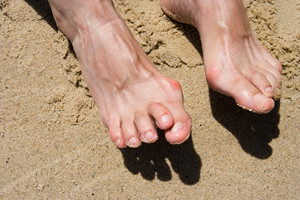 Hammertoe is caused by a deformity that bends the toes, causing them to be crooked. The joint affected is located at the bottom of the big toe and can often appear unsightly. The skin on top of the toes may look swollen, and corns and calluses will often form there, typically caused by friction as it rubs against the shoes. Causes of hammertoe are commonly due to shoes fitting poorly, which may cause the toes to be constricted for long periods of time. There may be a predisposed genetic trait that may cause this condition, in addition to diabetic patients and arthritis sufferers being prone to hammertoe. There are numerous treatment options available, depending on the severity of this condition. A consultation with a podiatrist is suggested for a proper diagnosis.
Hammertoe is caused by a deformity that bends the toes, causing them to be crooked. The joint affected is located at the bottom of the big toe and can often appear unsightly. The skin on top of the toes may look swollen, and corns and calluses will often form there, typically caused by friction as it rubs against the shoes. Causes of hammertoe are commonly due to shoes fitting poorly, which may cause the toes to be constricted for long periods of time. There may be a predisposed genetic trait that may cause this condition, in addition to diabetic patients and arthritis sufferers being prone to hammertoe. There are numerous treatment options available, depending on the severity of this condition. A consultation with a podiatrist is suggested for a proper diagnosis.
Hammertoe
Hammertoes can be a painful condition to live with. For more information, contact one of our podiatrists from New Jersey Foot & Ankle Centers. Our doctors will answer any of your foot- and ankle-related questions.
Hammertoe is a foot deformity that affects the joints of the second, third, fourth, or fifth toes of your feet. It is a painful foot condition in which these toes curl and arch up, which can often lead to pain when wearing footwear.
Symptoms
- Pain in the affected toes
- Development of corns or calluses due to friction
- Inflammation
- Redness
- Contracture of the toes
Causes
Genetics – People who are genetically predisposed to hammertoe are often more susceptible
Arthritis – Because arthritis affects the joints in your toes, further deformities stemming from arthritis can occur
Trauma – Direct trauma to the toes could potentially lead to hammertoe
Ill-fitting shoes – Undue pressure on the front of the toes from ill-fitting shoes can potentially lead to the development of hammertoe
Treatment
Orthotics – Custom made inserts can be used to help relieve pressure placed on the toes and therefore relieve some of the pain associated with it
Medications – Oral medications such as anti-inflammatories or NSAIDs could be used to treat the pain and inflammation hammertoes causes. Injections of corticosteroids are also sometimes used
Surgery – In more severe cases where the hammertoes have become more rigid, foot surgery is a potential option
If you have any questions please contact our office located in Oradell, NJ . We offer the newest diagnostic and treatment technologies for all your foot and ankle needs.
Does My Child Have Flat Feet?
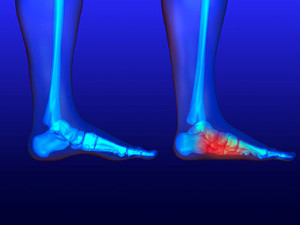 If the arch of the foot has not developed, causing the entire bottom of the foot to touch the ground while walking or running, your child may have a condition referred to as flat feet. Despite the fact that the majority of babies are born with flat feet, most typically outgrow it and the arches are fully formed by age 10. You may notice extreme flexibility in your child’s feet, possibly caused by soft ligaments, often resulting in fallen arches, or flat feet. This condition typically happens from a predisposed inherited trait, and little or no pain is generally experienced. If your child complains of any discomfort, there may be other foot issues present, and you may want to consider a consultation with a podiatrist for a proper diagnosis.
If the arch of the foot has not developed, causing the entire bottom of the foot to touch the ground while walking or running, your child may have a condition referred to as flat feet. Despite the fact that the majority of babies are born with flat feet, most typically outgrow it and the arches are fully formed by age 10. You may notice extreme flexibility in your child’s feet, possibly caused by soft ligaments, often resulting in fallen arches, or flat feet. This condition typically happens from a predisposed inherited trait, and little or no pain is generally experienced. If your child complains of any discomfort, there may be other foot issues present, and you may want to consider a consultation with a podiatrist for a proper diagnosis.
Flatfoot is a condition many people suffer from. If you have flat feet, contact one of our podiatrists from New Jersey Foot & Ankle Centers. Our doctors will treat your foot and ankle needs.
What Are Flat Feet?
Flatfoot is a condition in which the arch of the foot is depressed and the sole of the foot is almost completely in contact with the ground. About 20-30% of the population generally has flat feet because their arches never formed during growth.
Conditions & Problems:
Having flat feet makes it difficult to run or walk because of the stress placed on the ankles.
Alignment – The general alignment of your legs can be disrupted, because the ankles move inward which can cause major discomfort.
Knees – If you have complications with your knees, flat feet can be a contributor to arthritis in that area.
Symptoms
- Pain around the heel or arch area
- Trouble standing on the tip toe
- Swelling around the inside of the ankle
- Flat look to one or both feet
- Having your shoes feel uneven when worn
Treatment
If you are experiencing pain and stress on the foot you may weaken the posterior tibial tendon, which runs around the inside of the ankle.
If you have any questions please feel free to contact our office located in Oradell, NJ . We offer the newest diagnostic and treatment technologies for all your foot and ankle needs.
Read more about Flat FeetHow To Teach Children About Proper Foot Care
 Your child may begin to walk at about 12 months of age. Recent research has shown that it’s beneficial to walk barefoot as much as possible, which may help strengthen the foot muscles. It’s important to measure the feet every few months in the early years to ensure a proper fit while choosing shoes. As your child gets older, common ailments that can occur may include athlete’s foot, ingrown toenails, and plantar warts. It’s crucial to maintain daily foot care, which includes washing the feet in lukewarm water and drying thoroughly between the toes. Additionally, complaints about heel pain can be a common occurrence, typically resulting from playing sports. If the pain becomes severe, a consultation with a podiatrist may be suggested to alleviate any discomfort and to learn about possible treatment options.
Your child may begin to walk at about 12 months of age. Recent research has shown that it’s beneficial to walk barefoot as much as possible, which may help strengthen the foot muscles. It’s important to measure the feet every few months in the early years to ensure a proper fit while choosing shoes. As your child gets older, common ailments that can occur may include athlete’s foot, ingrown toenails, and plantar warts. It’s crucial to maintain daily foot care, which includes washing the feet in lukewarm water and drying thoroughly between the toes. Additionally, complaints about heel pain can be a common occurrence, typically resulting from playing sports. If the pain becomes severe, a consultation with a podiatrist may be suggested to alleviate any discomfort and to learn about possible treatment options.
Making sure that your children maintain good foot health is very important as they grow. If you have any questions, contact one of our podiatrists of New Jersey Foot & Ankle Centers. Our doctors can provide the care you need to keep you pain-free and on your feet.
Keeping Children's Feet Healthy
Having healthy feet during childhood can help prevent medical problems later in life, namely in the back and legs. As children grow, their feet require different types of care. Here are some things to consider...
Although babies do not walk yet, it is still very important to take care of their feet.
Avoid putting tight shoes or socks on his or her feet.
Allow the baby to stretch and kick his or her feet to feel comfortable.
As a toddler, kids are now on the move and begin to develop differently. At this age, toddlers are getting a feel for walking, so don’t be alarmed if your toddler is unsteady or ‘walks funny’.
As your child gets older, it is important to teach them how to take care of their feet.
Show them proper hygiene to prevent infections such as fungus.
Be watchful for any pain or injury.
Have all injuries checked by a doctor as soon as possible.
Comfortable, protective shoes should always be worn, especially at play.
If you have any questions please feel free to contact our office located in Oradell, NJ . We offer the newest diagnostic and treatment technologies for all your foot and ankle needs.
Read more about What to Do to Keep Your Child’s Feet HealthyCommon Foot Ailments Resulting From Obesity
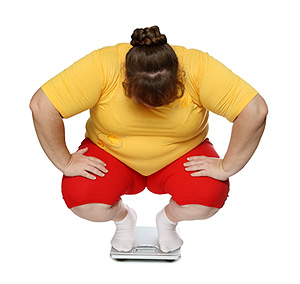 There can be several foot problems that may occur because of obesity. Some of these may include arthritis, skin issues, and general foot pain as a result of the weight the feet must endure. Excessive weight gain may cause a lack of mobility, potentially affecting the ability to perform proper exercises. Occasionally the feet may change sizes, which can affect the width and the arch of the foot. General foot pain may be experienced as the feet strain under body weight. Gout, a type of arthritis, is a common ailment that many obese people suffer from. It is an excess of uric acid that forms crystals in the joints, and in many cases, it may cause inflammation and severe pain. Please consider a consultation with a podiatrist for information about how obesity can be controlled to improve the condition of your feet.
There can be several foot problems that may occur because of obesity. Some of these may include arthritis, skin issues, and general foot pain as a result of the weight the feet must endure. Excessive weight gain may cause a lack of mobility, potentially affecting the ability to perform proper exercises. Occasionally the feet may change sizes, which can affect the width and the arch of the foot. General foot pain may be experienced as the feet strain under body weight. Gout, a type of arthritis, is a common ailment that many obese people suffer from. It is an excess of uric acid that forms crystals in the joints, and in many cases, it may cause inflammation and severe pain. Please consider a consultation with a podiatrist for information about how obesity can be controlled to improve the condition of your feet.
Obesity has become very problematic at this point in time and can have extremely negative effects on the feet. If you’re an obese individual and are concerned about your feet, contact one of our podiatrists from New Jersey Foot & Ankle Centers. Our doctors can provide the care you need to keep you pain-free and on your feet.
Obesity and Your Feet
Since your feet are what support your entire weight when standing, any additional weight can result in pain and swelling. Being overweight is one of the main contributors to foot complications.
Problems & Complications
Extra Weight – Even putting on just a few extra pounds could create serious complications for your feet. As your weight increases, your balance and body will shift, creating new stresses on your feet. This uneven weight distribution can cause pain, even while doing the simplest tasks, such as walking.
Diabetes – People who are overweight are at serious risk of developing type-2 diabetes, which has a drastic impact on the health of your feet. As you get older, your diabetes might worsen, which could lead to loss of feeling in your feet, sores, and bruises. You could also become more prone to various infections.
Plantar fasciitis – Pressure and stress that is placed on muscles, joints, and tendons can trigger plantar fasciitis, which is an inflammation of tissue that forms along the bottom of the foot.
If you have any questions please feel free to contact our office located in Oradell, NJ . We offer the newest diagnostic and treatment technologies for all your foot and ankle needs.
Read more about How Obesity Affects Your FeetFeatured Articles
- July 2025
- June 2025
- May 2025
- April 2025
- March 2025
- February 2025
- January 2025
- December 2024
- November 2024
- October 2024
- September 2024
- August 2024
- July 2024
- June 2024
- May 2024
- April 2024
- March 2024
- February 2024
- January 2024
- December 2023
- November 2023
- October 2023
- September 2023
- August 2023
- July 2023
- June 2023
- May 2023
- April 2023
- March 2023
- February 2023
- January 2023
- December 2022
- November 2022
- October 2022
- September 2022
- August 2022
- July 2022
- June 2022
- May 2022
- April 2022
- March 2022
- February 2022
- January 2022
- December 2021
- November 2021
- October 2021
- September 2021
- August 2021
- July 2021
- June 2021
- May 2021
- April 2021
- March 2021
- February 2021
- December 2020
- November 2020
- August 2020
- June 2020
- April 2020
- March 2020
- February 2020
- January 2020
- December 2019
- November 2019
- October 2019
- September 2019
- August 2019
- July 2019
- June 2019
- May 2019
- April 2019
- March 2019
- February 2019
- January 2019
- December 2018
- November 2018
- October 2018
- September 2018
- August 2018
- June 2018
- May 2018
- April 2018
- March 2018
- February 2018
- January 2018
- December 2017
- November 2017
- October 2017
- September 2017
- August 2017
- July 2017
- June 2017
- May 2017
- April 2017
- March 2017
- February 2017
- January 2017
